 The James Hutton Institute
The James Hutton Institute
This page is no longer updated. The Macaulay Land Use Research Institute joined forces with SCRI on 1 April 2011 to create The James Hutton Institute.
2nd LSIRD Conference on Livestock production in the European LFAs, Bray, Ireland. Dec '98
Biotope conservation with ruminants in Germany: the example of goats on shrub-infested
slopes
Pera Haumann
EU research project EQULFA, Department
of International Animal Husbandry, University of Kassel, Germany
Email: Haumann@wiz.uni-kassel.de
Introduction
In Germany, goats have always been housed and kept in small herds of one to five animals, mostly by crofters or workers but not by full-time farmers. The more recent requirement to cultivate cultural landscapes, makes it necessary to develop a new management and grazing system for goats in Germany. All existing German breeds have adapted to housed conditions. Only two native dairy breeds - the Weisse and the Bunte Deutsche Edelziege - and, to a smaller extent, for a few years, the South African Boer Goat for meat production are of any importance. None of the three named breeds is suitable for our aim of extensive grazing on marginal land. In order to develop a hardy alternative breed which can cope with extensive conditions, the breeding programmme for the Witzenhäuser Landschaftspflegeziege was set up (Tawfik & Rahmann, 1995).
If the agricultural use of land in less favoured areas is abandoned, biotopes created by grazing animals are endangered. The following article deals with shrub control on infertile grassland biotope sites (Nardion, Gentiano-Koelerietum). The main aspect was if and in which way secondary succession on abandoned farmland can be reduced by browsing goats. So far in Germany there has been considerable research done on cattle and sheep in biotope conservation. It has always been pointed out that their browsing ability is low. Goats are known for their high percentage of browsing but due to the small sized and widespread flocks there has never been a great attempt of doing research on goats. For developing a grazing system based on using goats in individual or mixed herds, research on goats' behaviour and impact on the grazed areas is needed.
Up to 50 percent of a goats intake can originate from feeding on shrubs. Out on the pasture, goats show much more temperament than cattle or sheep. They eat fast, are adventurous and like to play. With their low body weight they cause no ground damage. On slopes, goats do not create terraces. Also, sloped pastures fulfill their natural need for climbing.
In Summer 1996, a comparison of different animal groups grazing infertile grassland was carried out. In the chosen experimental site fifteen percent of the plots was covered with shrubs. In addition to Juniperus spp. mainly Rosa spp., Cornus sanguinea and Crataegus spp. were found. At the beginning of the trial their height was between 50 to 100 cm, shrubs over 200 cm rarely existed. It was decided to graze this area during the following years more intensely to stop secondary succession. The aim of the project was to record and compare the different grazing behaviour of goats in single species and mixed herds. In addition to the behaviour of the animals, the impact of grazing on the vegetation was analysed.
Another experimental site was located on a shrub
infested infertile grassland slope with a shrub coverage of 50
percent. The area had been abandoned for many years and was invaded
by Rosa spp., Cornus sanguinea, Prunus spinosa
and Crataegus spp.. For a three year trial four plots with
different conservation strategies were established and evaluated
for ecological and plant sociological changes.
Animals, material and methods
Behaviour of goats during single species and mixed grazing
During a one vegetation period trial at the experimental site "Keßstieg" in 1996 all goats originated from the breeding programme of the Witzenhäuser Landschaftspflegeziege while the sheep used for the mixed herd belonged to the endangered local breed Coburger Fuchsschaf. The stocking rate was 100 goats and 80 sheep per hectare during one week of grazing. As both herds had a total liveweight of 600 kg, the liveweight per hectare amounted to 3,000 kg on all plots. Such a high stocking rate for a short period of time simulates transhumance conditions. For landscape protection reasons it was prohibited to build a shelter for the animals. Water was provided in troughs with daily refill. Minerals and salt were offered as licks.
The experiment was carried out with goats, sheep
and goats and sheep in a mixed herd. For this article it is only
of interest how the goats behaved in a single species herd compared
to a mixed herd. During the experiment the animals were observed
for three days each at single species (G) and at mixed (G+S) grazing
(Figure 1). For every day, all behaviour was recorded. The observation
started at 6.30 am and finished at 9 pm.
Figure 1: Spatial division of experimental site „Keßstieg" for behaviour recording.
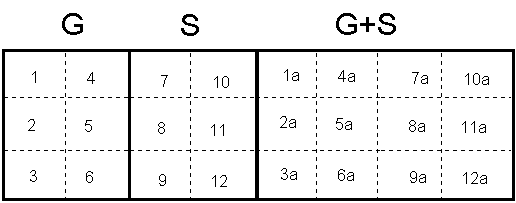
Compiled by Rahmann and Haumann (1998) according to Krehl (1997)
The time-part-method according to Fassnacht (1979) was used to quantify the behaviour. Records were kept on the following behaviour:
Feed intake from herb layer.
Browsing shrubs and trees.
Laying, resting, dozing - often combined with ruminating.
Standing without feeding, looking around - often caused by noises outside the enclosure.
Walking/running without the intention of feeding farther than three steps, often flight caused by unknown influences from outside the enclosure.
Drinking.
Social contacts, suckling lambs, fights.
Urinating; defaecating.
Body care, comfort behaviour.
Goats in single species and mixed herds grazing shrub infested infertile grassland
For the same one vegetation period trial, in every enclosure (G, G+S) fourteen shrubs of the leading species (Juniperus communis, Prunus spinosa, Crataegus spp., Rosa spp.) were selected. Before and after grazing they were measured for estimating the grade of usage according to the formula of RIEHL (1992). The grade of usage gives the reduction of shrubs through browsing (in percent). In addition, the proportion of shrub-browsing (in percent) was estimated (0 percent = no browsing of leaves, 100 percent = full defoliation).
To get an idea of the animals' feed intake the amount of biomass (in kg dry matter) was recorded before and after grazing. The difference in dry matter gives the amount of the animals intake. For this purpose four cutting samples taken at random in each paddock (G, G+S) were withdrawn before grazing started. Additionally two cuttings near the shrub area were taken. The cutting spots after grazing were located in direct neighbourhood to these plots. In this way it was ensured that the same type of vegetation was sampled. The cutting area was bounded by a tin-frame. In non-shaded-areas 1m2 was cut, under shrubs ¼ m2. Subsequently the samples were dried at 105°C.
The vegetation of the herb layer was mapped. Two
areas in each paddock were used for mapping. One was located in
a shaded spot - sized 20 m2 - the others were placed
in an area without shrubs - sized 2 m2. Six paddocks
were mapped before and after grazing respectively with the same
amount of plots in shaded and in sunny areas.For the precise evaluation
of the plant layers feed value, two mixed samples in every paddock
were taken- one of each in the shade of shrubs. These were examined
for their feed value with Weender- and van Soest-analysis.
Shrub control with goats - a comparison
Additionally, the results of a three years trial comparing different biotope cultivation methods is taken into consideration. On shrub infested infertile grassland with a shrub coverage of 50 percent three different cultivation methods were compared for their ecological conservation achievements and their impact on plant sociology:
M3G: Manual cleaning before the first vegetation period. Annual grazing with goats during the following three vegetation periods.
3G: Grazing with goats in three succeeding vegetation periods.
M: Manual cleaning before the first vegetation period.
Suc: No measure undertaken.
The manual cleaning was done by power scythe. During winter time (February), at the start of the trial, two paddocks were cleaned manually (M3G, M). In autumn (November), at end of the trial, all paddocks were cleaned to achieve a similar level of conservation. For this, the trial meets the effect of optimizing conservation. The biomass cut was weighed as green matter, labour input for this was documented.
The three years of grazing were done by goats from the breeding programme Witzenhäuser Landschaftspflegeziege. Table 1 shows the stocking density as well as the grazing times and periods. During grazing, no supplement feeding was allowed. The goats were weighed at the beginning and at the end of the grazing period. All labour and material input of every action due to grazing was documented. For tracing ecological impacts three mapping sites of 25 m2 each were set up. Every year before grazing started, a mapping of plant sociology according to Braun-Blanquet (measures grades of coverage) and according to Klapp (measures the yield portion) was done.
Table 1: Grazing periods and stocking rates
| 1st Year | 2nd Year | 3rd Year | |
| Grazing period
Rate of stocking (kg LW ha-1) Total stocking (kg LW ha-1 day-1) | 13.6. to 26.7.
1.736 48.608 | 14.7. to 28.7.
3.008 42.112 | 20.6. to 28.6.
5.006 40.048 |
Compiled by Rahmann (1998)
Results
Behaviour of goats during single species grazing
From the first day on the goats used different areas
of the paddock to perform special types of behaviour (Figure 2).
This pattern was maintained for the whole week. The goats spent
thirty-eight percent of the observation time at the resting place.
Sixty-three percent of the time was spent on feeding. The whole
herd of goats coordinated its movements during feeding.
Figure 2: Areas for different behaviour pattern of the goats.
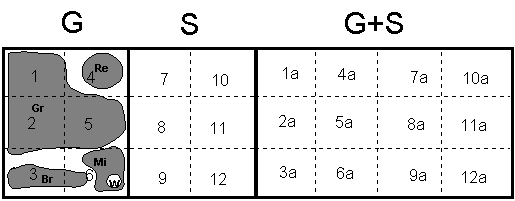
Br Browsing GrG Grazing of goats
W Water bowl and mineral licks
Compiled by Rahmann and Haumann (1998) according
to Krehl (1997)
Figure 3 shows that the main feeding times of the
goat herd were in the early hours of the morning and evening.
Up to 78 percent of the goats had their peak feeding periods between
7.30 am and 5.20 pm. Common resting-times during morning and afternoon
feeding were marked. In the late afternoon and in the evening
only a small part of the herd rested together. Three different
resting times were obvious: 9.30 am, 11.30 am and 3.30 pm. At
these times most goats lay down. In the early morning and evening
the goats browsed shrubs communally. The explanation for this
might be that the visiting of the bushy area had to be done with
the intention of browsing and for that reason the whole herd went
there together. At times of the day when only a small proportion
of the herd was lying down, the others grazed in the areas close
by.
Figure 3:
Daily pattern of the goats during single species grazing (average
of three observations)
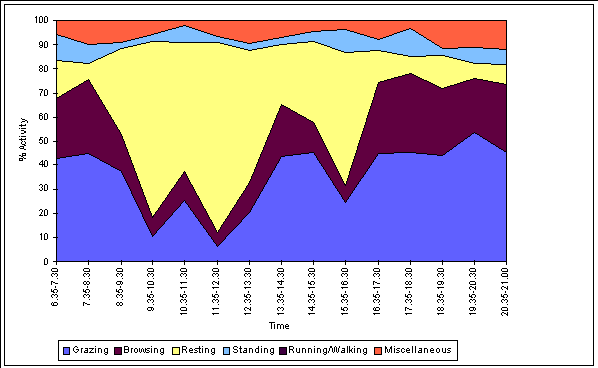
Source: Krehl (1997)
Behaviour of goats and sheep during mixed grazing
Both herds divided the enclosure into different areas.
The interests of each group were interacting. Figure 4 shows that
the resting places of goat and sheep were located close together.
Also, they were placed at the highest point of the slope. Both
herds never mixed but orientated their activities to each other.
Most of the time the sheep followed the goats. Shrubs were browsed
in the lower part of the enclosure and nearly only by goats.
Figure 4: Areas for different behaviour pattern of the goats and sheep.
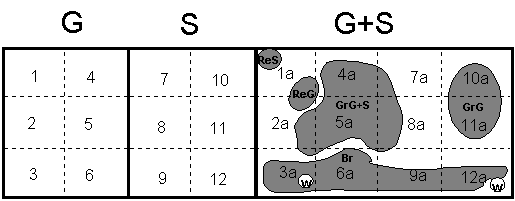
Br Browsing GrG Grazing of goats
GrS Grazing of sheep GrG+S Grazing of goats and sheep
W Water bowl and mineral licks
Compiled by Rahmann and Haumann (1998) according
to Krehl (1997)
During mixed grazing the spectrum of chosen feed changed extremely. The goats spent 61 percent of the whole feeding time with browsing and 39 percent with grazing (vs 30 percent browsing, 70 percent grazing in individual grazing) (Table 2). The sheep changed their behaviour in a similar way: Browsing decreased from 12 percent to 8 percent while the proportion of grazing rose from 88 percent to 98 percent of the total feeding time.
Table 2: Average endurance of activities shown by goats and sheep in single species and in mixed grazing
| Activity | Goats, individual grazing | Goats,
mixed grazing | Sheep, individual grazing | Sheep,
mixed grazing |
| Feed intake | 63% | 65% | 58% | 69% |
| Browsing | 30% | 61% | 12% | 2% |
| Grazing | 70% | 39% | 88% | 98% |
| Resting | 26% | 22% | 35% | 24% |
| Standing | 5% | 7% | 5% | 6% |
| Walking/running | 1% | 3% | 1% | 0% |
| Miscellaneous (e.g. playing) | 5% | 3% | 1% | 1% |
Compiled by Haumann (1997) according to Krehl (1997)
Figure 5: Daily pattern of the goats during mixed grazing (average of three observations)
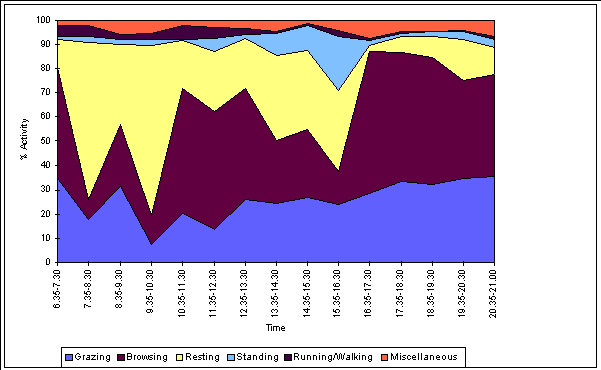
Source: Krehl (1997)
Figure 6: Daily pattern of the sheep during mixed grazing (average of three observations)
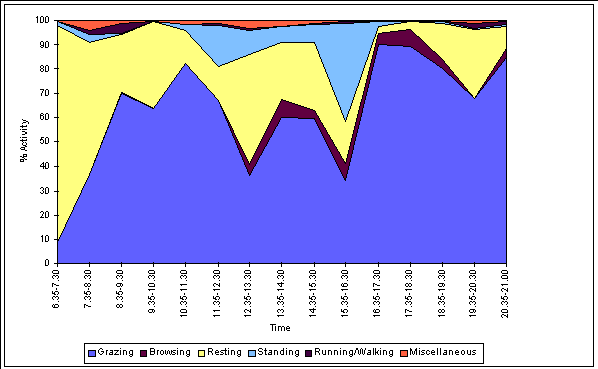
Source: Krehl (1997)
Goats in single species and mixed herds grazing shrub infested infertile grassland
In paddock G all occuring shrub species were browsed. Height as well as diameter were reduced. The needles of Juniperus communis were browsed the least. Here the goats preferred peeling the bark off. The species was nearly destroyed in this paddock. The bark of other shrub species was not touched much. It was noticed that the peeling of bark was influenced principally by the thickness of branches and stems and less by shrub species. This means that small shrubs are not peeled but branches and stems thicker than 4 cm in diameter. The goats were browsing the leaves of shrubs intensively. After grazing no shrub or wood could be found whose leaves had not been browsed. Altogether branches were not completely defoliated. During behaviour recording, it was also registered that the goats spent most of their time near or in the shrubs.
In paddock G+S differences both in height and diameter were noticed. During mixed grazing the extent of shrub-leaf-browsing increased. Having in mind that sheep stopped browsing nearly totally and goats increased it during mixed grazing, it is likely that the goats were responsible for this. The grade of usage in paddock G+S was higher than the one of paddock G.
During the grazing period total live weight of the sheep and of the goats herd increased. This proves that infertile grassland is an appropriate pasture for small ruminants. A closer look shows that the dams of both herds lost a little weight (-3.3 and -8.5 kg) while the kids and yearlings gained weight (+3.5, +6.0 and +16.3 kg). The weight loss of dams resulted from their higher energy requirements. Besides their own maintenance requirements, they had to produce milk for their kids. This additional demands could not be covered by the available feed on the pasture and for this reason live weight was reduced. As long as these weight losses are in a range of less than 10 percent they are considered normal. Even under housing conditions with need orientated feeding, suckler dams might lose body condition. This finding proves that grazing infertile grassland with goats without supplement feeding can meet the animals demands.
Table 3: Differences in weight before and after the grazing period
| Mother-Goats | Kids | Total
- Goats - | Mother-Sheep | Lambs | Total
- Sheep - | |
| Number of Animals | 7 | 13 | 20 | 6 | 10 | 16 |
| Weight at the beginning (kg LW) | 301.0 | 299.5 | 600.5 | 327.5 | 276.5 | 601.0 |
| Weight at the end (kg LW) | 297.7 | 309.0 | 606.7 | 319.0 | 292.8 | 611.8 |
| Difference in weight (kg LW) | -3.3 | +9.5 | +6.2 | -8.5 | +16.3 | +7.8 |
Compiled by Haumann (1998) according to Winterfeld (1997)
The difference in dry matter before and after grazing results in 0.54 t/ha of intake by the sheep out of the herb layer. In a 0.2 ha sized paddock this comes up to 0.1 t of total intake. With an energy content of 600 starch equivalents/kg DM, an average 9,143 starch equivalents were eaten every day. Sheep need about 8,571 starch equivalents per day for maintenance and grazing activities (+ 50 percent). These numbers prove that the sheep covered their needs nearly exclusively from the plant layer.
For the goat paddock the difference in dry matter
was 0.38 t/ha which is equivalent to 0.08 t per 0.2 ha. According
to these results 6,515 starch equivalents/day were eaten from
the plant layer. The energy requirements of 11,429 starch equivalents
per day (maintenance + 50 percent for grazing activities) leads
to the solution that the goats covered more than 40 percent of
their energy requirements with browsing shrubs. This also proves
that grazing low yielding biotopes with goats meets the animals
needs.
Changes in vegetation
The three years' trial with 50 days of grazing already brought changes in vegetation (Table 4). The grade of coverage of the grass/herb-layer increased especially in paddock M3G. Looking at the number of grass and herb species, they increased in the grazed paddocks to a great extent. This is due to the smaller amount of matted grass in the grazed plots. Also the feed value of grass and herbs increased in grazed paddocks.
Table 4: Comparison of vegetation parameters at different cultivation strategies
| M | M3G | 3G | Suc | |
| Grade of coverage grass/herb-layer 1 | 55% | 100% | 80% | 80% |
| Height grass/herb-layer
Feed value grass/herb-layer 2 | 60 cm
2,08 | 40 cm
2,43 | 40 cm
3,17 | 60 cm
2,42 |
| Grade of matted grass | 45% | 0% | 20% | 60% |
| Height of matted grass (cm) | 0.15-0.20 | 0 | 0.05-0.10 | 0.15-0.20 |
| Number of herb species | 17 | 29 | 21 | 19 |
| Yield portion herbs2 | 25% | 50% | 30% | 20% |
| Feed value herbs 2 | 1.62 | 1.97 | 2.03 | 1.70 |
| Shannon-index 3 for herbs | 2.74 | 2.24 | 2.64 | 2.79 |
| Number of grass species | 4 | 7 | 8 | 4 |
| Yield portion grass 2 | 75% | 50% | 70% | 80% |
| ... of which Brachypodium pinnatum | 53% | 5% | 18% | 65% |
| Feed value grass2 | 2.23 | 2.88 | 3.66 | 2.6 |
| Shannon-index 3 for grass | 0.94 | 1.38 | 1.92 | 0.66 |
according to Braun-Blanquet.
according to Klapp. The mapping was done in May. The mapping sites à 25 m2 were located in the same altitude, approximately 2.5 m from each other.
The Shannon-index is the international used form of evaluting variance of species and their distribution. It is calculated with the formular H'= -pi lnpi where p is the frequency of the species. The higher the value the more even is the spread of species of a certain amount of species. Number of species and yield portion were used for the calculations in these tables.
Compiled by Rahmann (1998)
Achievements in shrub control
Using goats for shrub control, compared to exclusive manual cleaning, definitely helped to reduce shrub mass (Table 5). Also, the number of shrub species decreased in grazed paddocks. Shrub volume and average height of shrubs was less in paddock 3G than in other paddocks. Biomass growth per year was lowest in paddock 3G, followed by paddock M3G, paddock Suc. and at least paddock M. Table 5: Shrub growth after three years of different cultivation strategies
| M | M3G | 3G | Suc | |
| Shrub mass at the beginning 1994 (kg) | 5,200 | 5,200 | 5,200 | 5,200 |
| Removed at the beginning (kg) | 5,200 | 5,200 | 0 | 0 |
| Removed at the end1 (kg) | 9,906 | 1,148 | 5,803 | 9,297 |
| Removed at the beginning and the end (kg) | 15,106 | 6,348 | 5,803 | 9,297 |
| Biomass growth in total (kg) | 9,906 | 1,148 | 603 | 4,097 |
| Biomass growth per year (linear) (kg) | 3,302 | 383 | 201 | 1,366 |
| Number of shrub species at the end (25 m2)
Average height of shrubs (m) | 3
1.84 | 2
1.18 | 2
0.52 | 7
2.05 |
| Shrub volume (m3/ha)
Biomass per 10 cm height of shrubs (kg) | 10,172
0.974 | 2,480
0.463 | 4,856
1.173 | 8,836
1.053 |
| Shannon-index for shrubs (m3) | 0.61 | 0.49 | 0.47 | 1.09 |
1 In kg green biomass at cleaning
Compiled by Rahmann (1998)
Discussion
In Germany, animal husbandry has always had major influence on the development of landscapes. Grassland in less favoured areas was mostly formed by grazing sheep and cattle. Changes in agricultural structure make it impossible for small scale farms to keep up traditional husbandry systems in these areas. Consequently landscapes are no longer being created as a free by-product, and traditional pasture land, now longer used for grazing, is endangered by proliferation of shrubs. At the same time, the desire to use historic landscapes as recreational areas is growing. Many people connect grazing animals with the idea of a specific image of landscape, and there is a growing public demand for preserving "open" landscapes.
If the agricultural use of land in less favoured areas is abandoned, biotopes created by grazing animals are also lost. Shrub clearance has a fundamental impact on maintenance or even improvement of infertile grassland in its typical appearance. For this, it is one of the main conservation tools. The use of goats in shrub control does not only help to reduce biomass it also saves the costs of taking away and disposing of cut biomass. Also, the animal products - meat or milk - can be sold and provide supplementary income.
If grazing livestock are used for biotope conservation, their special behaviour has to be taken into consideration. In Germany, considerable research has been done on feeding and spatial behaviour of cattle, sheep and horses but goats have always been neglected. With the breeding programme of the Witzenhäuser Landschaftspflegeziege now the interest in goats' behaviour is growing. Useful for introducing goats in biotope conservation was the finding of Krehl (1997) that goats adapt their feeding behaviour depending on whether they are kept in a single species or mixed herd. Goats and sheep in a mixed herd seem to adjust their feeding behaviour - while sheep are nearly exclusively grazers, goats are browsers.
Other experiments on landscape cultivation (Schömig,
1987; Kleinpeter & Kleinpeter, 1987; Riehl, 1992; Stahmann,
1994; Schröder, 1995) have shown that the exclusive use of
goats is only appropriate if shrub coverage totals over 40 percent.
For this reason, it is not recommended to graze infertile grassland
with only goats over several years. Also, the choice of a grazing
livestock species and the decision to use a single species or
mixed herd depends on the management goal for the particular type
of biotope. In general, a new management system is planned which
uses goats for shrub clearance for the first years after basic
manual cleaning. Additionally, mechanical maintenance is required
to cut back problem plants. After two or three years - depending
on the shrub coverage - the goats should be joined by a flock
of sheep. As soon as the shrubs are under control, a single species
grazing system with sheep should be established. Finally, it has
to be pointed out that evaluating the animals abilities for shrub
clearance is only one step in the development of biotope conservation
strategies. Another important aim which has to be taken into consideration
too is the economic evaluation of biotope conservation with grazing
animals. Livestock grazing systems are only meaningful if they
allow the farmer an appropriate living. This objective is being
considered by others in the EQULFA-project.
References
Kleinpeter, M. & H. Kleinpeter (1988): Zeigen als Naturschützer. Der Ziegenzüchter, 3: xxx
Krehl, A. (1997): Verhalten von Ziegen und Schafen in der Weidehaltung. Diplomarbeit, FG Int. Nutztierzucht u. -haltung, Universität Gesamthochschule Kassel, Witzenhausen.
Rahmann, G. (1998): Das Beispiel der Entbuschungsleistung der Ziege. Internes Papier FG Int. Nutztierzucht und -haltung.
Riehl, G. (1992): Untersuchungen zur Pflege von Brachflächen und verbuschten Magerrasen durch Ziegen- und Schafbeweidung. Dissertation Universität Göttingen, Göttingen.
Schömig, G. (1987): Burenziegen pflegen die Landschaft im Südschwarzwald. Der Ziegenzüchter, 1: 23-28.
Schröder, C. (1995): Rassespezifische Eignung von Kaschmir-, Buren- und Edelziegen zur Erstpflege von Sukzessionsflächen. Dissertation Universität Gesamthochschule Kassel, Fachbereich 11, Witzenhausen.
Stahmann, F. (1994): Eignugn von Ziegen und Schafen zur Landschaftspflege. Der Ziegenzüchter, 1: 2-6.
Tawfik, E.S. & G. Rahmann (1995): Zucht einer Landschaftspflegeziege - Programm und Methodik. Mitteilungsblatt des FG Int. Nutztierzucht und -haltung. Universität Gesamthochschule Kassel, Witzenhausen.
Winterfeld, D. v. (1997): Möglichkeiten zur
Entbuschung und Pflege von Halbtrockenrasenstandorten im Werra-Meißner-Kreis,
insbesondere durch Beweidung mit Ziegen und Schafen. Diplomarbeit,
FG Futterbau u. Grünlandökologie, Universität Gesamthochschule
Kassel, Witzenhausen.